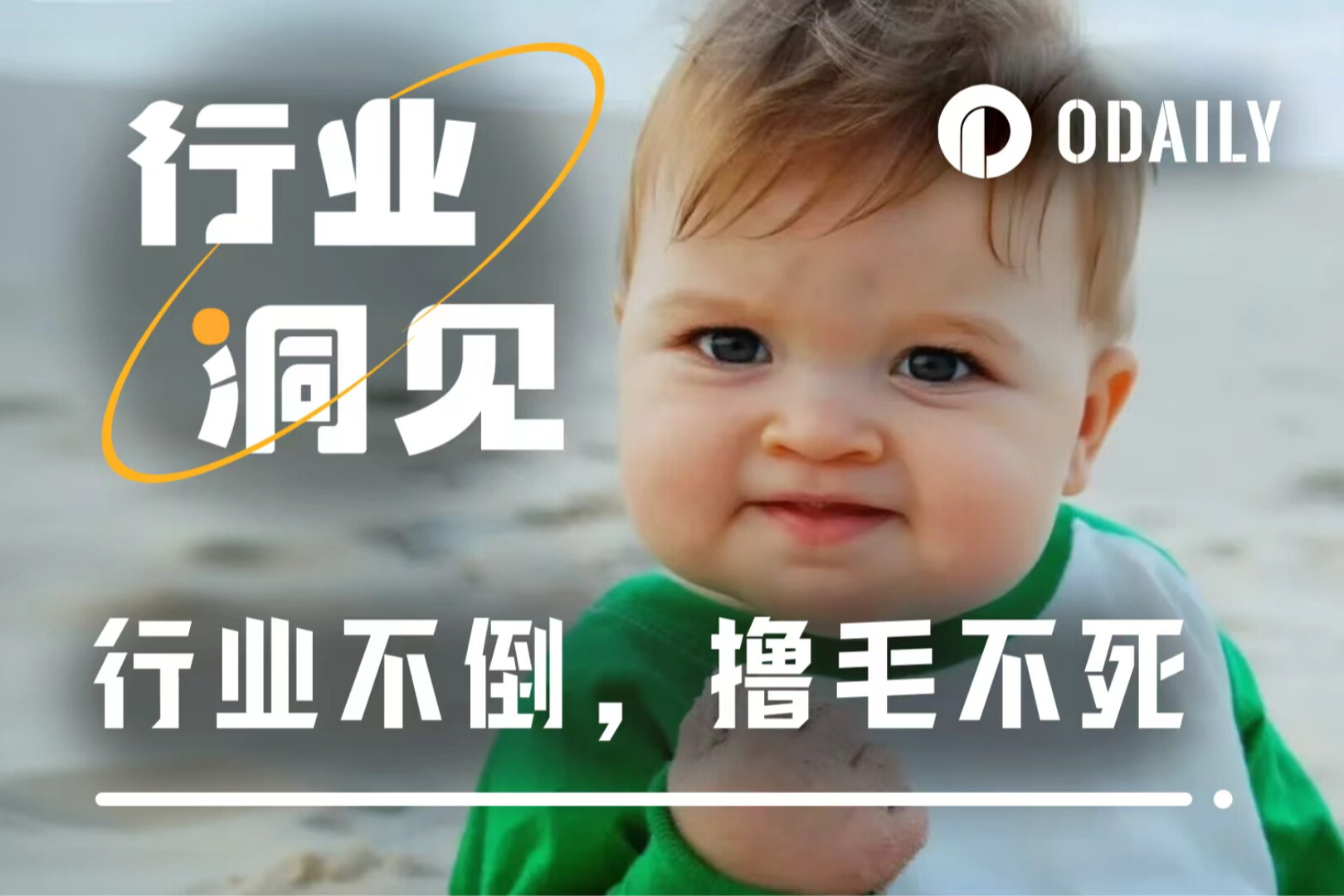DappRadar metaverse first quarter report: virtual land transactions hit a new high
On March 23, DappRadar released a research report on the first quarter of the metaverse. Data shows that NFT transactions in the Metaverse increased in the first quarter of 2023, totaling $311 million. According to the report, virtual land transactions saw a record 147,000 transactions, with platforms such as Yuga Labs' Otherside and MG Land dominating. On the other hand, NFTs related to land in the Otherside metaverse saw $222 million in Q1 volume, a 237% increase from the previous quarter.
From decentralized fashion shows to high-end luxury brands jumping on the NFT bandwagon, the first quarter of 2023 saw unprecedented growth and innovation in the virtual reality world. According to the original text of the report, PANews compiled excerpts about the overall development and dynamics of the Metaverse, NFT and chain game industries.
The virtual world of the Metaverse presents a bull market
Since the beginning of 2023, the Metaverse’s Virtual Worlds market has been in a bull market: NFT transaction volume reached US$311 million in the first quarter, a quarter-on-quarter increase of 277.12%; the number of land transactions reached 146,690, a record high , an increase of 83.56% month-on-month. This is the best quarter for Virtual Worlds since Terra crashed in May 2022.
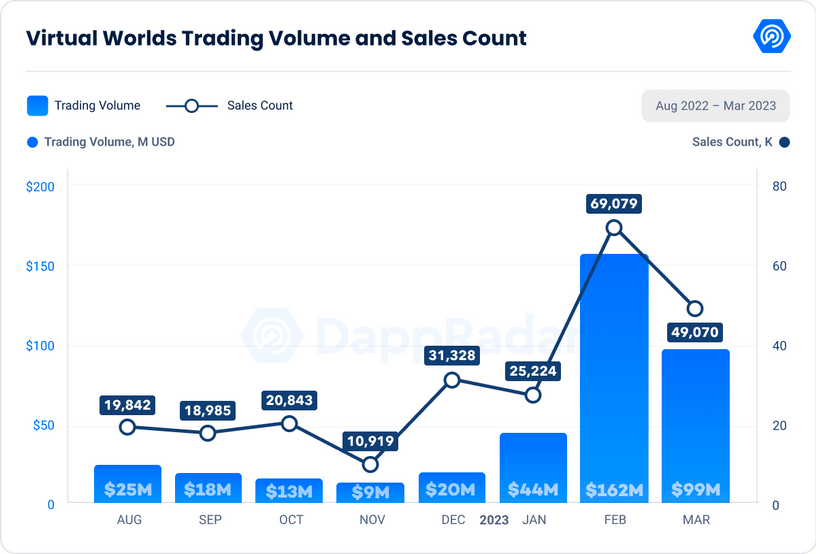
Among them, Otherdeed for Otherside was the virtual world application with the highest trading volume in the first quarter, with a transaction volume of 222 million US dollars, a quarter-on-quarter increase of 237.34%, and sales of 65,399 transactions, a record high, and a quarter-on-quarter increase of 138.80%.
Additionally, MG Land, which launched earlier this year, was a standout with almost $60 million in transactions and 45,219 sales. In MG Land, users can build a decentralized space with an independent domain name on each MG land, where NFT users can freely meet new friends, socialize, play games and carry out various activities. It is worth mentioning that the high trading volume of MG Land is mainly due to the fact that some NFT whales use it for Blur’s point-scoring operation, so as to obtain more tokens in the next airdrop of BLUR.
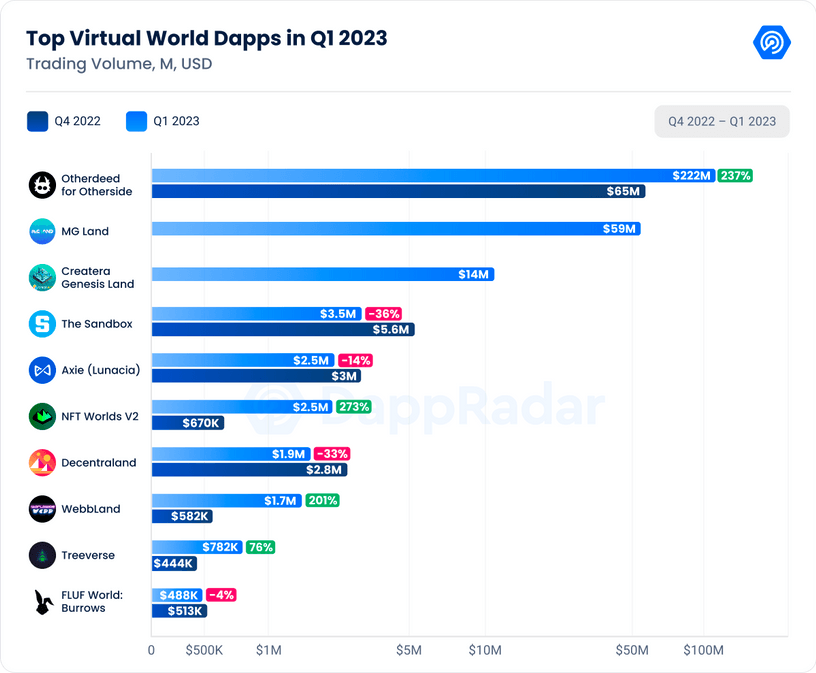
Related Reading:
Related Reading:"a16z launched the metaverse project again, how Createra, which casts land for free, builds a creator ecology"
The Sandbox ranked fourth this quarter with $3.5 million in transactions and 7,338 transactions, a decline of 36.83% and 72.60%, respectively. In February, they had a land sale and despite poor results, they secured multiple partnerships with Charles & Keith, Havas Play, GCEX and Saudi Arabia. Additionally, The Sandbox has announced its expansion into Germany with the acquisition of game development studio Sviper, while leading Japanese animation company TOEI ANIMATION is entering The Sandbox's Metaverse.
The chain game "Axie Infinity" ranked fifth. Driven by Homeland Season 1, the transaction volume of its virtual land was 2.5 million US dollars, but it still decreased by 14.66% compared with the previous quarter. Additionally, a parcel of land in Axie Infinity made it into the top 10 for single parcel sales for $150,452 (105 ETH).
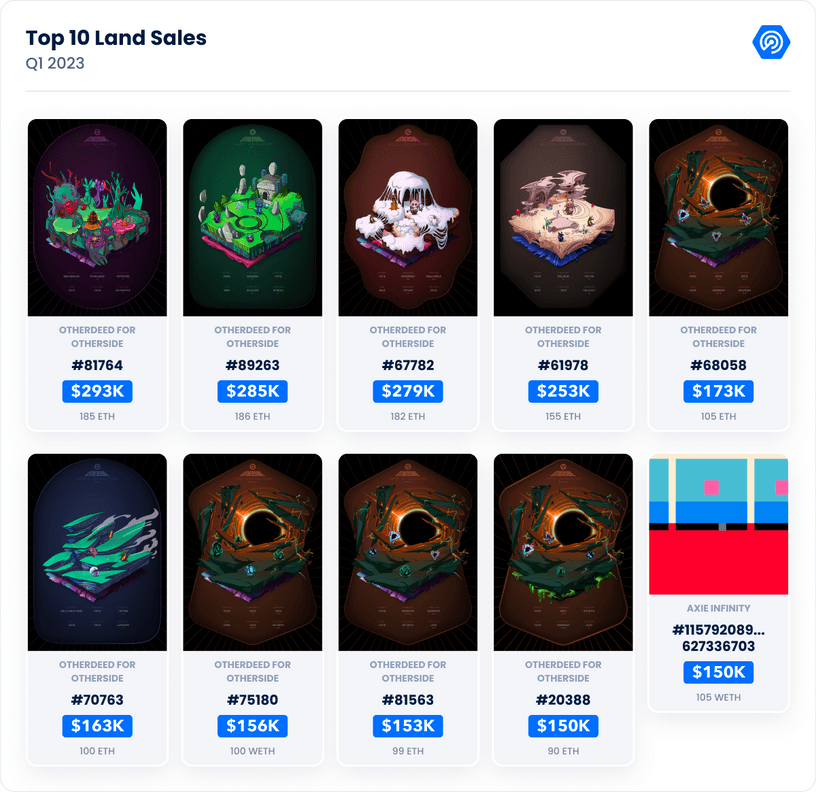
NFT Worlds ranked sixth with a total transaction volume of US$2.5 million, an increase of 273.03% month-on-month. In July last year, "Minecraft" (Minecraft) announced the ban on the use of NFT or other blockchain technology in the game, which dealt a heavy blow to NFT Worlds, a former top project, and then announced multiple cores based on "Minecraft". Mechanics create a new game and platform. The first step in NFT Worlds' reboot of the game is the launch of the Armory, a combination wardrobe, store, and game preview. Eight months after the project was forced to shut down, this collection of Minecraft-themed virtual worlds has come back to life.
WorldWide Webb's transaction volume was US$1.7 million, an increase of 201.72% quarter-on-quarter. In late February, Worldwide Webb received a $10 million investment from Pantera Capital. The metaverse game developer said it would use the funds to integrate more NFT series and hire more employees.
All in all, virtual worlds got off to a good start in the first quarter, with top projects seeing increased deals and sales, and with more funding and partnerships, we can expect more growth and innovation in the virtual world space going forward .
The marriage of fashion brands and NFTs is still evolving
The NFT industry has achieved tremendous growth in the past year, and the fashion industry has also entered the market rapidly. Many brands have begun to enter the NFT market to provide their customers with a unique digital fashion experience. DappRadar has been tracking 39 NFT fashion collections, which have historically sold 293,399 units and totaled $366.4 million in sales.
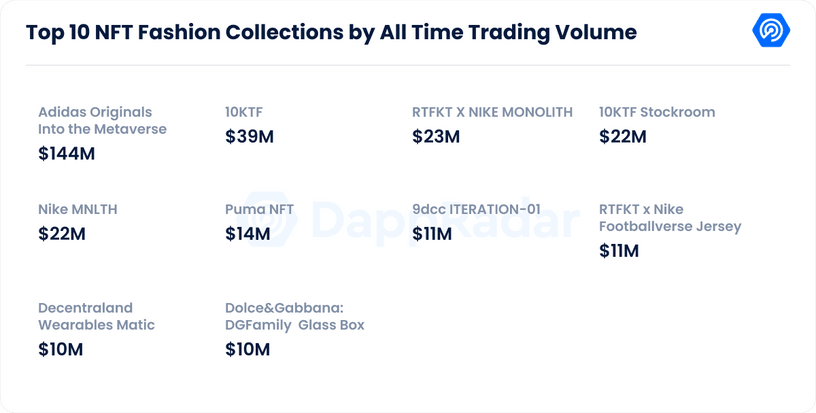
One of the most successful NFT fashion collections is Adidas Originals into the Metaverse. The collection's all-time high was $144 million with sales of 47,399 pieces. It’s a collection of 30,000 digital collectibles on the ethereum blockchain, with holders earning exclusive physical merchandise, as well as access to digital utilities that are “continuously developed.” Since making waves in Web3 in 2021, the Adidas Originals NFT collection has been at the forefront of the digital fashion revolution.
However, the landscape of top NFT fashion collections has changed in the first quarter of 2023. The market is currently dominated by 10 KTF collections, accounting for 74% of all traded volume of NFT fashion collections.
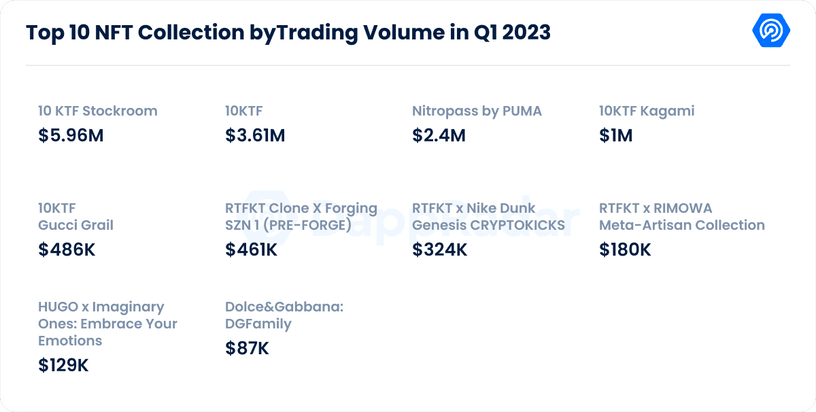
Launched on September 17, 2021, 10 KTF is an online store located in New Tokyo (a virtual city) run by the fictional world-renowned craftsman Wagmi-san. Previously, Yuga Labs, the parent company of Bored Ape Yacht Club, acquired Web3 ecosystem WENEW and its flagship NFT series 10 KTF, further enriching its portfolio of popular NFT projects.
Another fashion NFT brand with a large share of the NFT fashion industry is RTKFT, which has 3 collections in the top 10 and a transaction value of $966,479. Founded in January 2020, RTFKT Studios initially operated a virtual footwear and apparel production business, and was acquired by NIKE for $1 billion in December 2021. RTFKT plays an important role in bringing collectibles to the next stage by exploring untapped potential in the Metaverse and anticipating where related demand is headed.
Overall, the NFT fashion industry is growing rapidly, and luxury brands are jumping on the bandwagon to offer their customers a unique digital fashion experience. While the Adidas Originals into the Metaverse collection was the first to succeed, the current market is dominated by 10 KTF and RTKFT. The NFT industry is still in its early stages, and we will see more luxury brands entering the market in the future.
Chain Games and Metaverse project investment reached 502 million US dollars
Blockchain gaming and Metaverse projects have been attracting significant investment over the past few years, and have brought in $3.7 billion in 2021. In 2022, the industry continues its upward trend, raising a total of $7.6 billion in funding for the year. Going into the first quarter of 2023, the industry is doing well, with a total of $502 million invested in blockchain games and Metaverse projects.
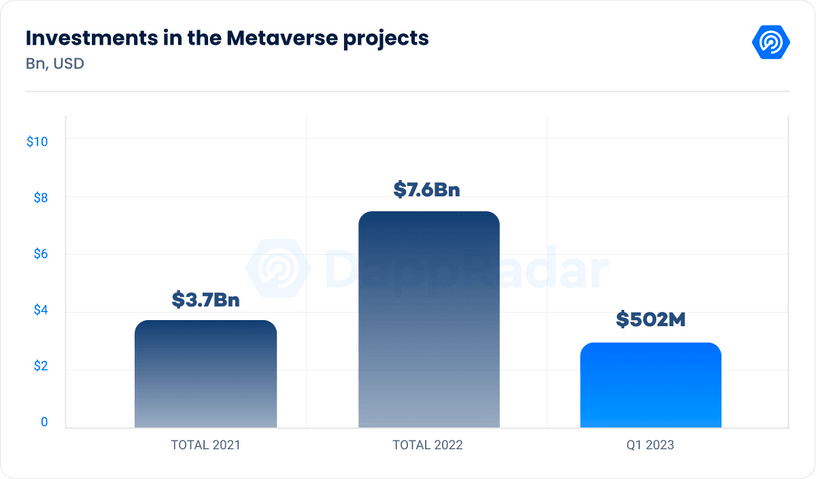
According to statistics, blockchain games and Metaverse projects received the most funds in the first quarter of 2023, accounting for 32.7% of the total investment, of which technology companies focusing on Metaverse projects received 5.3% of the total funds. Infrastructure projects followed with 31.5 percent of funding, while investment firms received 24 percent.
Today digital fashion is on the rise, with 60% of Gen Z and 62% of Millennials citing how they present themselves online as more important than in-person, a trend that also shows up in investing. Digital fashion and avatars have been the main focus of investment in the sector during the first quarter. As DressX has raised $15 million, the company aims to expand its vision for the future of fashion and improve the performance of its app and NFT marketplace.
According to a study by Barclay Card, nearly 10% of UK consumers "return shopping", buying clothes for the sole purpose of posting fashion pictures on social media and then initiating a return. Experts believe this trend is good for digital fashion. Morgan Stanley predicts the digital fashion market will reach $50 billion by 2030, as the gaming industry becomes an important indicator of the potential of brands and designers.
In addition to investments in the digital fashion space, there is another focus for the blockchain gaming and metaverse industries this quarter, namely those projects that develop payment systems for digital economies in games and metaverses. That's why Tilia, the Metaverse payments platform that recently raised its total funding to $22 million, aims to enable reliable dynamic payments for online games, creator platforms, social commerce, and other digital social worlds.
As the digital economy continues to grow, people's unique needs for the digital economy are expanding, and payment systems that meet this demand are becoming more and more important. Current payments infrastructure was built for traditional commerce and has not kept up with the changing demands of a digital, creator-driven economy. Tilia's focus will be on developing a payment system that unlocks new revenue streams for online creators and the platforms they build, whether it's a gaming world, a social platform, or a next-gen marketplace.
Original link


